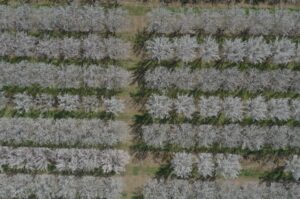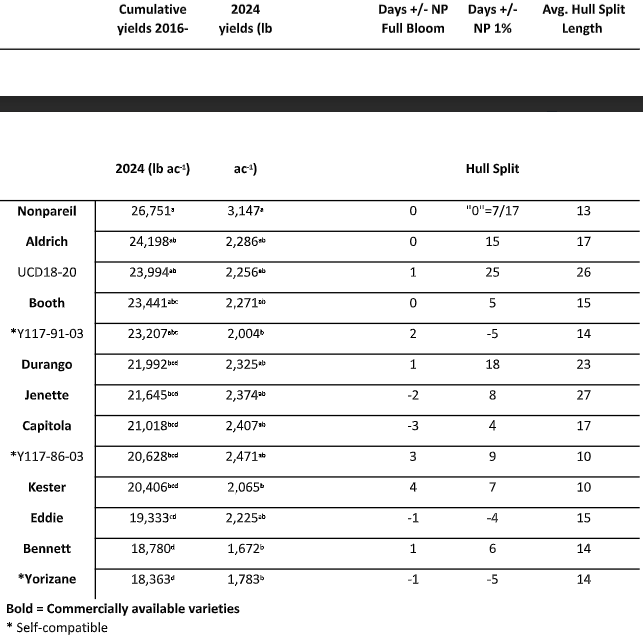Luke Milliron, UCCE Orchards Butte, Glenn, Tehama
Phoebe Gordon, UCCE Madera and Merced
Roger Duncan UCCE Stanislaus, Emeritus

Photo 1: Drone photo of the UC Cooperative Extension almond variety trial at the CSU, Chico Farm. In the trial every other row is Nonpareil, and the other rows are 12 tree replicates of 29 almond varieties (credit: Conservation Irrigation Lab).
What varieties do we know the most about?
New almond varieties are always coming out from public and private breeding programs around the world. It’s tempting to plant the latest and greatest. Unfortunately, many growers in our area of Northern California have been burned by new varieties in recent years – Bennett-Hickman bud failure issues, and partial incompatibility of Independence and Shasta on the Krymsk 86 rootstock. Witnessing these painful and costly stories leads me to always ask growers to start variety selection with what has worked best for them in the past. Although, I have written extensively about the new mysterious issues with the Monterey variety in the northern Sacramento Valley, for other well-established varieties we have a good sense for both their advantages and warts. Your processor, experienced nursery professionals, and your farm advisor are all great resources for deciding what to plant.
What do we know a fair amount about?
A well-known nurseryman once said, “It takes 20 years to prove a variety”. In the 3 rd generation of almond variety trials planted at three locations across the Central Valley in 2014, we don’t have 20 years of insights, however we have learned a great deal in the past 11 years (see table).
In the table, looking at the cumulatively top five yielding varieties at the Butte site we see that despite efforts to try and develop superior varieties for nearly 150 years, Nonpareil still reigns king not only for kernel quality, but in our trials for yield as well. UCD 18-20 and Booth are high-yielding self-sterile varieties – unfortunately they can both suffer from very high doubles (15-31% in some years), and high doubles might help explain their high yields.
Y117-91-03 is an up-right, vigorous, and high-yielding self-fertile variety from the USDA. Its kernels consistently have few defects, although they do produce a smaller kernel than Nonpareil (0.9g vs. 1.2g in 2024, respectively). It shakes well, has had very few insect or disease problems, and harvests before Nonpareil. It is currently under virus clean-up at the Foundation Plant Services facility at UC Davis and could be released to nurseries for propagation as early as fall 2025. Of the remaining varieties in the top five, Y117-86-03 and Yorizane also from the USDA are self-fertile (*), while the other varieties above are self-sterile.
Yorizane is the first variety to be released from these regional trials. It is self-fertile, has excellent kernel quality, and has shown few insect or disease problems, although we have seen an undefined staining on the kernel pellicle in some years. The Yorizane tree is smaller than a Nonpareil but has shown to be one of the most yield efficient varieties in the trials. Yorizane yields have performed considerably better at the Stanislaus and Madera sites compared to Butte. Despite the mediocre yields at Butte, Yorizane is a top five yielding variety when all three sites are averaged. Given its high yield efficiency and compact size – there is potential it could perform better on a higher vigor rootstock than Krymsk 86 and/or at a tighter spacing than the 18 x22 at the CSUC Farm. Yorizane blooms and harvests about the same time as Nonpareil and shakes very well. Because this variety was developed by the USDA, it is available from all nurseries with no proprietary fees.
Kester has yielded well and has exhibited few problems. However, it blooms too late to be a good Nonpareil pollinizer and harvests too early to be harvested with Butte, so it is difficult to see how this variety fits.
You can learn more about results from all three trial sites at: fruitsandnuts.ucdavis.edu/resourcesreports and growingthevalleypodcast.com/podcastfeed/rvt3-10.
What are we starting to learn about?
In the fall of 2022 and spring of 2023, the 4 th generation of UC almond variety trials funded by the Almond Board of California were planted in Butte, Stanislaus, and Kern counties. Another 30 varieties are under evaluation – the vast majority of which are self-fertile. New test varieties are from breeding programs at UC Davis, USDA, Australia, Spain, and Burchell Nursery. This is also the first time we have been allowed to include the popular Independence variety in our UC trials, and I have added an Independence rootstock trial to my site. Other varieties under evaluation that you may have heard of include Shasta, Pyrenees, Lassen, and Conway – all from Burchell nursery. At the Stanislaus site with tight 10’ x 20’ spacing, minimal pruning, and the high vigor Hansen 536 rootstock, Yorizane yielded just over 1,000 lbs to the acre in the second leaf! Meanwhile at the Butte site – the planting has had a rocky start with a late spring planting out of cold storage resulting in high mortality and extensive replant needs. We will keep you updated in the years to come in articles, podcasts, and field days on what we learn from these three new trial sites.
What do we know the least about and will require extensive testing?
Self-fertile Nonpareil is an exciting topic of coffee shop talk these days. Both Sierra Gold Nursery ( FruitionOne™ ) and Burchell Nursery (Nonpareil SC+) announced in late 2024 their partnerships with biotech companies to develop a self- fertile Nonpareil. Both nurseries plan to begin delivering these trees to growers in 2027. However, many questions remain. My current understanding is that the self-fertile Nonpareil trees from both nurseries would not be considered GMOs in the United States because of the less invasive genetic modifications made through the CRISPR technique when compared to the earlier generations of biotech modified crops. However, the EU, our largest export region, currently would consider kernels from these trees as GMOs. Former farm advisor David Doll (aka The Almond Doctor) who farms in Portugal thinks there is a “reasonable probability that the EU will loosen the rules that define ‘genetically modified’” in the next five years. Of course this is only a prediction. Clearly the road forward for self-fertile Nonpareil and potentially other previously self-sterile almond varieties is not yet lit. I hope to be trialing these trees as early as 2026. This is a case where researchers can learn early lessons and mistakes with these new trees so that growers aren’t in the potentially costly position of finding themselves in the role of experimental researcher.



Leave a Reply